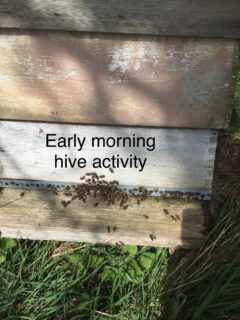 For a few days in April I thought the beekeeping season had started! The weather was warm, the bitter, easterly wind had finally dropped and the bees were going crazy for nectar and pollen. Some of my hives were so full of bees they were virtually pushing the crown-board off so desperate were they for more space. The euphoria was short-lived, though, as the temperatures dropped again and we went back to the colder conditions which we have been experiencing for so long now.
For a few days in April I thought the beekeeping season had started! The weather was warm, the bitter, easterly wind had finally dropped and the bees were going crazy for nectar and pollen. Some of my hives were so full of bees they were virtually pushing the crown-board off so desperate were they for more space. The euphoria was short-lived, though, as the temperatures dropped again and we went back to the colder conditions which we have been experiencing for so long now.
However, during the brief respite, I was able to remove the crown-boards from my fuller hives, place a queen excluder on top of the brood box and add the first empty super of the season. The bees took no notice whatsoever, as the foraging bees were out in the fields leaving the hive with a much smaller work-force of mainly young bees.
The hives which I worked on had bees occupying nearly all of the frames, so they were ready for the extra space. That is, except for one hive. When I lifted the crown-board it felt heavier than I would have expected. This very quickly showed itself to be because the bees had attached a comb to it which they’d filled with honey! It turned out that when I had hived this swarm last season I had put a dummy board at the edge of the frames I gave them so that the volume of their “home” was not too great for the number of bees and they would be able to conserve their brood nest temperature better. So they had five frames on which to build their nest, a dummy board (which is basically a false wall that restricts the volume of hive available to the bees), followed by four frames on the remote side of the dummy board with a gap between the last frame and the brood box wall. However, bees being bees, when they needed more space to expand their nest, they dived under the dummy board and started to draw combs in the empty frames that I had left there for storage purposes (my storage purposes!). Additionally, since the dummy board took up the space of about half a standard frame, there was an even bigger gap at the outside edge of the spare frames and it was in this gap that they built their wild comb attached to the crown-board.
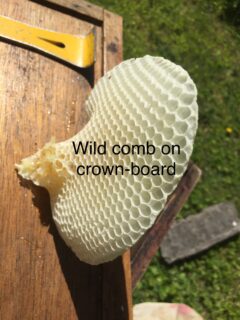 I cut the comb away from the crown-board, removed the dummy board, eased all the drawn combs back together so that they were touching with no gaps and finally added two new frames with starter strips of wax foundation. I was then able to add the queen excluder and first super to give them the space they needed to store the incoming nectar. All of this without the need for smoke or spray-mist and no interest from the bees in what I was doing – a joy to work in such conditions!
I cut the comb away from the crown-board, removed the dummy board, eased all the drawn combs back together so that they were touching with no gaps and finally added two new frames with starter strips of wax foundation. I was then able to add the queen excluder and first super to give them the space they needed to store the incoming nectar. All of this without the need for smoke or spray-mist and no interest from the bees in what I was doing – a joy to work in such conditions!
The other hives that I was able to check were not as heavily populated with bees and are not quite ready for a super. If a super is added too early it can have detrimental consequences for the bees as the greatly increased volume allows heat loss from the brood nest. This gives the bees a lot more work to do to maintain the ideal conditions of temperature and humidity, so is best left until the bees are on about 7 or 8 combs in the brood box. Another two weeks and these less-advanced hives will be ready for their supers and hopefully the weather will improve to the point that I can do a disease check but to do that at this time could result in chilling of the brood and certainly loss of heat from the brood nest.
Last month I mentioned the bees’ need for water and included a picture of my bird bath that was used by the bees as a watering point. Well, the number of bees accessing the bird bath has increased phenomenally since then which is a good indication that things are looking promising. The bees are using the water to dilute their stores in order to be able to feed their young and also to regulate the temperature and humidity in the hive. Judging by the rate at which the bees are emptying the bird bath there’s an awful lot of brood needing feeding and some large brood nests needing controlled conditions!
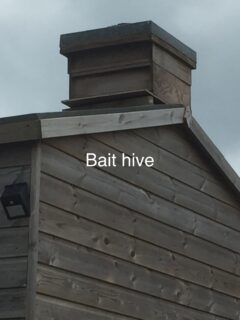 It’s almost swarming season again, though the recognised indicator of intended swarming, viz. the presence of drones, has not been evident yet. I actually haven’t seen a single drone so far this season! However, in anticipation of early swarms I have already installed my bait hives round and about. I have four in my home apiary, three others in my garden, two at one of my out-apiaries and another on the shed of my beekeeper friend which picked up four swarms of black bees last year. I have also set up an empty hive in my apiary with some old brood comb, though I am not expecting anything from this. Bees, when they are swarming, tend to fly at a height of about 12’ to 15’, so most of my bait hives are set up in trees or on the rooves of out-buildings, where they are more likely to be found by scout bees looking for a new home.
It’s almost swarming season again, though the recognised indicator of intended swarming, viz. the presence of drones, has not been evident yet. I actually haven’t seen a single drone so far this season! However, in anticipation of early swarms I have already installed my bait hives round and about. I have four in my home apiary, three others in my garden, two at one of my out-apiaries and another on the shed of my beekeeper friend which picked up four swarms of black bees last year. I have also set up an empty hive in my apiary with some old brood comb, though I am not expecting anything from this. Bees, when they are swarming, tend to fly at a height of about 12’ to 15’, so most of my bait hives are set up in trees or on the rooves of out-buildings, where they are more likely to be found by scout bees looking for a new home.
But, as it is not unknown for bee swarms to occupy empty hives at ground level, I though I might as well prime this empty hive as a bait hive – just in case! When bees are looking for a new home they are wanting about 45 litres of space to establish their new brood nest and colony. If any potential residence also has a smell of bees or beeswax, indicating that bees have previously occupied this enclosure, then it is more attractive to a swarm. This is achieved by placing an old comb of beeswax in an appropriate chamber, eg a brood box or, as I have got, a large flower tub.
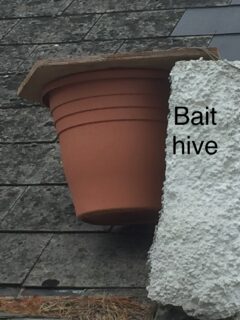 Once the swarm has arrived in the bait hive, it is transferred to a permanent brood box and the old comb is left in the bait hive, so there is no danger of the old comb being a disease vector. I also smear a small amount (no more than a drop or two) of lemongrass essential oil at the entrance and inside the hive as a further attractant. It is believed that this smell is similar to the pheromone released from the Nasenov gland of the honey bee and is a “homing” scent which is attractive to bees.
Once the swarm has arrived in the bait hive, it is transferred to a permanent brood box and the old comb is left in the bait hive, so there is no danger of the old comb being a disease vector. I also smear a small amount (no more than a drop or two) of lemongrass essential oil at the entrance and inside the hive as a further attractant. It is believed that this smell is similar to the pheromone released from the Nasenov gland of the honey bee and is a “homing” scent which is attractive to bees.
Bad news about my out-apiary hive that blew over twice during the winter. It looks as if the queen has perished, as when I went to give them their first super I found just a small cluster of bees on the combs in the brood box. I need to go back again with a nuc box to put them in, so that they can keep warm more easily, at which point, once the weather allows again, I will take a closer look for the queen. I’ve also been wondering whether it was actually wind that blew the hive over or maybe was it cattle managing to get into the hive area when the electric fence was down and knocking the hive off its stand. I guess I’ll never know but the result is the same whichever is the cause.
I have come across a few queen wasps already this year, hibernating in our lined bedroom curtains and emerging on warm days thinking that Spring is here (it’s really not, guys!).
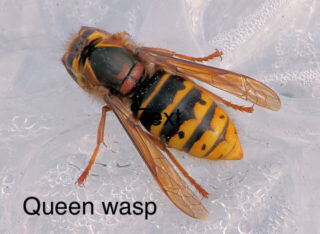 They won’t be building nests this season! However, there will be sufficient queens around in nature which will escape my eagle eye and establish nests so they can do their predatory job on the lesser garden pests before they turn their attentions to my hives, at which point they had better look out!
They won’t be building nests this season! However, there will be sufficient queens around in nature which will escape my eagle eye and establish nests so they can do their predatory job on the lesser garden pests before they turn their attentions to my hives, at which point they had better look out!
As you know from last month’s blog, the Asian (or yellow-legged) Hornet queens are also starting to emerge and if they get the timing right (ie they emerge when the weather has finally settled to a warmth they can survive in), they too will be looking to build nests. So please keep a lookout for them and also for their nests. The nests look similar to those of the European hornet but the primary nests will be about four or five feet off the ground, most likely in a bushy shrub.
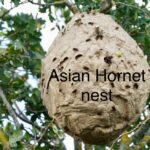 Secondary nests won’t be established until later in the season – I’ll tell you when that time comes. It’s easy to differentiate the two hornet types from their abdominal bandings:
Secondary nests won’t be established until later in the season – I’ll tell you when that time comes. It’s easy to differentiate the two hornet types from their abdominal bandings:
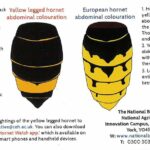 Please don’t just ignore suspected Asian Hornet sightings or nests and hope they’ll die or go away – they won’t – and once established in the UK the beekeeping community will have a huge problem on their hands and your precious honey might become a rarity.
Please don’t just ignore suspected Asian Hornet sightings or nests and hope they’ll die or go away – they won’t – and once established in the UK the beekeeping community will have a huge problem on their hands and your precious honey might become a rarity.
For Asian Hornet sightings (or suspected sightings) contact alertnonnative@ceh.ac.uk
or give me a call and I’ll alert our Asian Hornet Action Team (AHAT) on the Roseland.
Colin Rees 01872 501313 07939 971104 colinbeeman@aol.com

